1. Introduction
 Foxconn recently shipped a new series of motherboards, supporting Core2Duo chipsets, with an integrated VGA chipset onboard. While this may not be the fastest motherboard around, we are eager to see how well it performs with the 945G/ICH7R chipset combination. We will of course be comparing this motherboard with other motherboards based on the 965/975 chipsets.
Foxconn recently shipped a new series of motherboards, supporting Core2Duo chipsets, with an integrated VGA chipset onboard. While this may not be the fastest motherboard around, we are eager to see how well it performs with the 945G/ICH7R chipset combination. We will of course be comparing this motherboard with other motherboards based on the 965/975 chipsets.
- Foxconn 945G7AD-8EKRS2H
Foxconn C51XEM2AA is based on Intel's 945G chipset, which supports Intel®Core™2Extreme, Core™2Duo, Pentium®4EE, Pentium®D, Pentium®4, CeleronD processors for Socket LGA775. It features 1066/800/533MHz(FSB), dual-channel un-buffered DDR2 667/533/400 x 4DIMMs support, up to a maximum of 4GB.

- Main features
- Adopting the newest standard of CPU voltage modules-VRM11, Foxconn 945G7AD can perfectly support the latest intel desktop processor Conroe series
- Fool-proof and well organized IDE connector and power connector design
- 4 phases with 1 low 2 high design enable the power support better
- The main board adopts Intel 945G Northbridge and ICH7R Southbridge. Four of the serial ATA 2 ports supporting NCQ command system offer the higher transferring and extension
- Adopt Realtek ALC 861 - High Definition Audio, provide 7.1 channel audio system and support Azlia technology. That makes users easy buildup Home entertainment
- All of the front connector are painted colorful. Any one can plug and remove front panel headers easily by different colors
- Provides 5V standby Led, which bring great convenience for DIY customers
- Integrates Intel GMA950 graphic card and provide a extra discrete PCI-E 16X graphic card slot.
- Full specifications
| Processor: |
Intel® Core™2 Extreme, Core™2 Duo, Pentium® 4 EE, Pentium® D,Pentium® 4, Celeron D, processors , Socket T (LGA775) |
| Chipset: |
Intel 945G + ICH7R |
| Front Side Bus: |
1066 / 800 / 533 MHz FSB |
| Memory: |
Dual Channel DDR2 667 / 533 / 400 x 4 DIMMs, Max 4GB |
| VGA on Die: |
Integrated |
| Expansion Slots: |
1 x PCIe x16, 2 x PCIe x1, 3 x PCI |
| IDE: |
ATA 133 x 2 |
| Serial ATA(SATA)/RAID: |
Serial ATAII x 4 + eSerial ATAII x 1 with RAID 0, 1, 0+1 |
| Audio: |
7.1 channel Audio, ALC 861 (Realtek) |
| LAN: |
GbE LAN, Realtek RTL RTL8111B (PCIe) |
| IEEE1394: |
1394a x 2, VIA VT6308P |
| Back Panel I/O Ports: |
1 set 7.1 channel Audio jack (6 jacks)
1 x PS/2 keyboard
1 x PS/2 mouse
1 x parallel
4 x USB 2.0
1 x RJ45
1 x 1394a
1 x VGA port
1 x S/PDIF Coax out |
| Internal I/O Connectors: |
2 x USB 2.0 headers support 4 ports
1 x S/PDIF out header
1 x Buzzer
1 x IrDA header
1 x CD IN header
1 x Intruder
1 x Speaker
1 x Front panel header
1 x AUX IN header (reserve)
1 x Front Audio header
1 x 1394a header
1 x COM2 header
1 x TPM |
| BIOS Features: |
LPC 4MB, ACPI 2.0b, APM 1.2, PnP 1.0a, SMBIOS 2.3, USB 2.0 |
| Support CD: |
Drivers, DirectX, Adobe Reader, SuperUtilities, Norton Internet Security, Create RAID tool, Live update |
| Standards/Manageability: |
PCI 2.3, USB2.0, DMI 2.0 |
| Special Features: |
SuperBoot, SuperBIOS-Protect, SuperLevel, SuperStep, Ratio Free, Q.B.U |
| Form Factor: |
ATX (12" x 9.6") |
2. The Package
Foxconn's retail package is very simple. Pricing starts from US $120, making it a very affordable solution for entry level users:


Below is a list of what's included in the retail package.
- A flyer with installation and motherboard information
- A CD with drivers
- 1x UltraDMA cable
- 1x FDD cable
- 1x I/O shield
- 2x SATA cables
- 2x SATA power cables

The board itself, is very well layed out and most components can be easily identified.

The Intel GMA950 chipset is located under the heatsink near the bottom left corner, while the Intel 945G is at the centre, under the Foxconn labeled heatsink The user can install a PCI-E graphics card, that automatically disables the GMA950 chipset, for faster and better graphics capabilities. 3x PCI slots are also available, as are 2x2 ATA133 for HDD and optical storage drives, and of course 4x SATA2 connections.
There are several extra connections for USB, Front Panel Audio, COM2 and Firewire on the back. However, Foxconn hasn't included the associated cables for these in the retail package.
The back I/O panel has the usual connectors, 7.1 channel Audio jack (6 jacks), PS/2 keyboard and mouse,
1 x parallel,
4 x USB 2.0,
1 x 1Gbit LAN,
1 x 1394a,
1 x D-Sub15 VGA port and lastly,
1 x S/PDIF Coax out:

Despite Foxconn's attempts, there are some issues with the layout design. For example, you cannot use a bigger cooling fan than the stock, since there are components (see capacitors in photo below) that get in the way.

Another problem is the PCI-E slot, since in order to remove any installed card, you must be careful not to damage nearby components:

Lastly, if you have a PCI-E card installed, you cannot get access to the memory modules, there being no room to open/close the secure jack easily. So, you have to first remove the VGA card, install the memory modules and then re-install the VGA card. Not the best solution in our opinion.

3. The Bios
The BIOS is the Phoenix - Award, and should be very familiar to most users.


In the Advanced chipset selection, we can set many options like CPU features, Boot devices and other standard features:


The most interesting screen is the "Fox Central Control Unit", which includes all the overclocking features:

Foxconn has three pre-defined overclocking settings, from default (i.e. no OC)

to Step1, where FSB rises to 273MHz and CPU voltage increases by +0.05V

Step 2, with higher FSB and voltages

and finally Step 3,

CPU Voltages can be either higher or lower than the default, in 0.01V step increments.

The FSB, DRAM and ICH voltages can be modified as well.



4. Installation
After installing an Intel XE6800 processor, we used Everest Ultimate Edition 2006 and were able to get more information about the motherboard and chipsets:



Foxconn LiveUpdate is a very useful programme that can automatically search for a new BIOS, drivers and utilities versions. Our motherboard was shipped with the latest (beta):

Finally, lets see the default running specs of the processor, using CPU-Z:


Memory was set to Auto and worked at a 4:5 FSB:RAM ratio.


5. Tests - Page 1
In order to test the board, we used the following setup (this is the same setup for the comparison motherboards as well):
- CPU: Intel XE6800
- Memory: Crucial Ballistix 2x1GB PC2-8000
- PSU: OCZ GameXStream GXS600 SLI-Ready
- VGA: MSI 7600GT Silent (stock memory/core timings)
- HDD: WD 800JB
For comparison, we post results from a reference Core2Duo motherboard, the Intel D975XBX rev00 with 1351 BIOS. In both cases, we used Intel's Core2Duo XE6800 with default speed (2933.4MHz). Each motherboard was left to select memory timings. For the Intel motherboard, we manually set FSB to 1066MHz

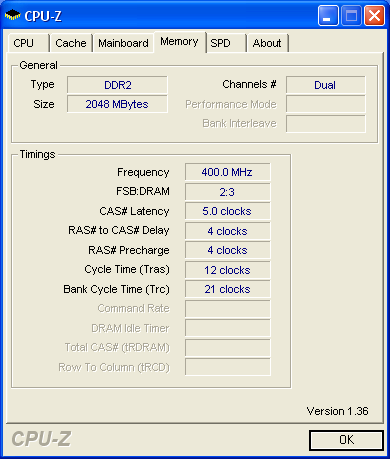
- Everest Ultimate Edition 2006
 EVEREST Ultimate Edition is an industry leading system diagnostics and benchmarking solution for enthusiast PC users, based on the award-winning EVEREST Technology. During system optimizations and tweaking, it provides essential system and overclock information, advanced hardware monitoring and diagnostics capabilities to check the effects of the applied settings. CPU, FPU and memory benchmarks are available to measure the actual system performance and compare it to previous states or other systems. Furthermore, complete software, operating system and security information makes EVEREST Ultimate Edition a comprehensive system diagnostics tool that offers a total of 100 pages of information about your PC.
EVEREST Ultimate Edition is an industry leading system diagnostics and benchmarking solution for enthusiast PC users, based on the award-winning EVEREST Technology. During system optimizations and tweaking, it provides essential system and overclock information, advanced hardware monitoring and diagnostics capabilities to check the effects of the applied settings. CPU, FPU and memory benchmarks are available to measure the actual system performance and compare it to previous states or other systems. Furthermore, complete software, operating system and security information makes EVEREST Ultimate Edition a comprehensive system diagnostics tool that offers a total of 100 pages of information about your PC.
The software has several built-in tests for both memory and CPU/FPU. Due to the fact that the 945G supports only 800MHz FSB, we expected somewhat lower memory performance, something that was more or less confirmed:

In the FPU/CPU tests, the Foxconn 945G7AD displayed higher performance than Intel's 975XBX:

Lastly, the Sisoft Sandra 2007 SP1 scores, support the fact that Cache and Memory are nor as strong on the Foxconn as on the Intel motherboard, but the Foxconn motherboard was faster in all the CPU tests.

6. Tests - Page 2
 PCMark®05 is everything you need to reliably and easily measure the performance of your PC and determine its strengths and weaknesses. With PCMark05, you will be able to select the optimal upgrades for your existing PC, or choose the right new PC that fits your specific needs. This easy-to-use product gives you the same tools and knowledge that virtually every professional tester in the industry uses.
PCMark®05 is everything you need to reliably and easily measure the performance of your PC and determine its strengths and weaknesses. With PCMark05, you will be able to select the optimal upgrades for your existing PC, or choose the right new PC that fits your specific needs. This easy-to-use product gives you the same tools and knowledge that virtually every professional tester in the industry uses.
Below you can see all three available scores, memory, CPU and total. Looking at the CPU score, the Foxconn motherboard is faster, while Intel's 975XDX is faster in the memory tests. The overall score is in favor of the Foxconn motherboard.
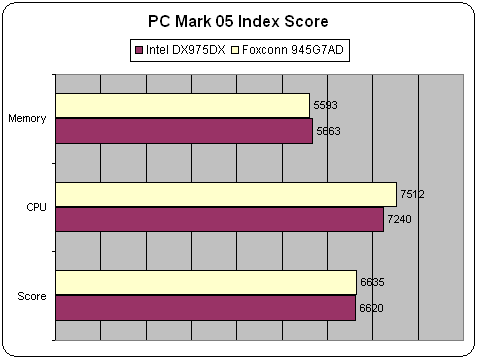
 3DMark®06 is the worldwide standard in advanced 3D game performance benchmarking. A fundamental tool for every company in the PC industry as well as PC users and gamers, 3DMark06 uses advanced real-time 3D game workloads to measure PC performance using a suite of DirectX 9 3D graphics tests, CPU tests, and 3D feature tests. 3DMark06 tests include all new HDR/SM3.0 graphics tests, SM2.0 graphics tests, AI and physics driven single and multiple cores or processor CPU tests and a collection of comprehensive feature tests to reliably measure next generation gaming performance today.
3DMark®06 is the worldwide standard in advanced 3D game performance benchmarking. A fundamental tool for every company in the PC industry as well as PC users and gamers, 3DMark06 uses advanced real-time 3D game workloads to measure PC performance using a suite of DirectX 9 3D graphics tests, CPU tests, and 3D feature tests. 3DMark06 tests include all new HDR/SM3.0 graphics tests, SM2.0 graphics tests, AI and physics driven single and multiple cores or processor CPU tests and a collection of comprehensive feature tests to reliably measure next generation gaming performance today.
Below we can find the CPU and total score. In both cases, Foxconn's performance was higher.
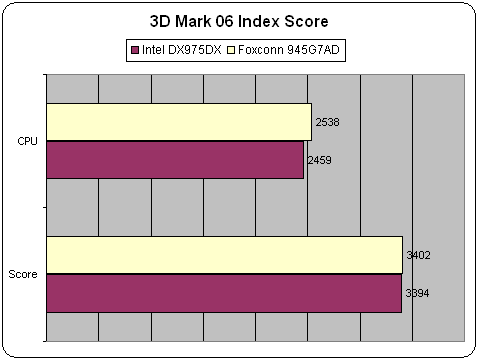
Science Mark 2.0 is an attempt to put the truth behind benchmarking. In an attempt to model real world demands and performance, SM2 is a suite of high-performance benchmarks that realistically stress system performance without architectural bias. Science Mark 2.0 is comprised of 7 benchmarks, each of which measures a different aspect of real world system performance.
 Pov-Ray s a high-quality, totally free tool for creating stunning three-dimensional graphics. It is available in official versions for Windows, Mac OS/Mac OS X and i86 Linux. The source code is available for those wanting to do their own ports. We used Pov-Ray 3.7beta15 for all tests, since it supports Dual Core CPUs. We used the build-in benchmark as suggested from developers.
Pov-Ray s a high-quality, totally free tool for creating stunning three-dimensional graphics. It is available in official versions for Windows, Mac OS/Mac OS X and i86 Linux. The source code is available for those wanting to do their own ports. We used Pov-Ray 3.7beta15 for all tests, since it supports Dual Core CPUs. We used the build-in benchmark as suggested from developers.
The Pov-Ray benchmark uses more CPU raw power and the Foxconn motherboard was again stronger. But with ScienceMark, Intel's 975XDX was faster.

7. Tests - Page 3
Nero Digital
One of the major advantages of having Core2Duo is video encoding. Nero Digital is one of the better known Digital formats, offering both ASP and AVC encoder.

_Profiles.png)
For our tests, we used the latest version of Nero Recode v2.3.1.8 as packaged in Nero Reloaded v7.5.0.1. As a source, we used a VOB file, of 5mins duration. We encoded in two modes (ASP, AVC) with exactly the same preferences (same bitrate and Dual pass). The encoding time displayed below is what Nero Recode reported. The lower the time taken, the better. All results are displayed in seconds.

Both motherboards had exactly the same performance with ASP encoding. But with the more CPU intensive AVC encoding, the Foxconn motherboard was faster.
 CINEBENCH is the free benchmarking tool for Windows and Mac OS based on the powerful 3D software CINEMA 4D. Consequently, the results of tests conducted using CINEBENCH 9.5 carry significant weight when analyzing a computer’s performance in everyday use.
CINEBENCH is the free benchmarking tool for Windows and Mac OS based on the powerful 3D software CINEMA 4D. Consequently, the results of tests conducted using CINEBENCH 9.5 carry significant weight when analyzing a computer’s performance in everyday use.
Especially a system's CPU and the OpenGL capabilities of its graphics card are put through their paces (even multiprocessor systems with up to 16 dedicated CPUs or processor cores). During the testing procedure, all relevant data is ascertained with which the performance of different computers can subsequently be compared, regardless of operating system. All tests were done with the latest available build (R9.5), and the sum of each subtest is displayed at the following chart..
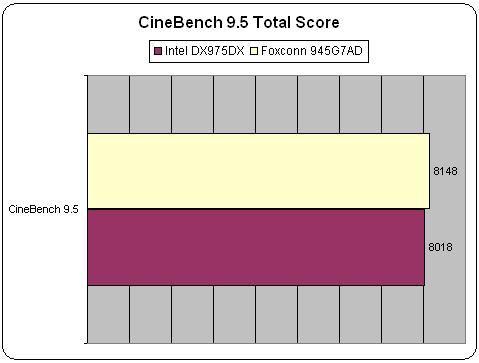
CineBench total score for the Foxconn mobo is higher than Intel's.
 SuperPI has become an utility to benchmark modern systems. In August 1995, the calculation of pi up to 4,294,960,000 decimal digits was succeeded by using a supercomputer at the University of Tokyo. The program was written by D.Takahashi and he collaborated with Dr. Y.Kanada at the computer center, the University of Tokyo. This record-breaking program was ported to personal computer environment such as Windows NT and Windows 95 and called Super PI.
SuperPI has become an utility to benchmark modern systems. In August 1995, the calculation of pi up to 4,294,960,000 decimal digits was succeeded by using a supercomputer at the University of Tokyo. The program was written by D.Takahashi and he collaborated with Dr. Y.Kanada at the computer center, the University of Tokyo. This record-breaking program was ported to personal computer environment such as Windows NT and Windows 95 and called Super PI.
The software offers up to 32M calculations of PI numbers, for all CPUs we tested up to 8M calculations and sum them up for a total score.
The Foxconn motherboard was faster by some seconds...
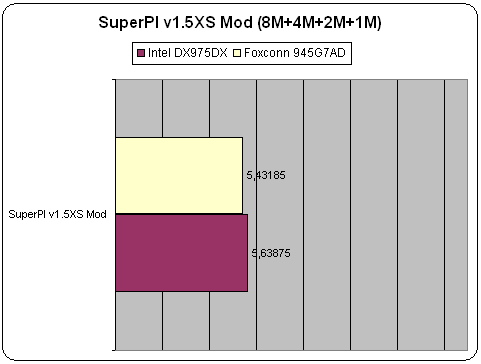
8. Overclocking
Foxconn has in the BIOS, several settings for overclocking your CPU. From our tests, we found ourselves limited to 280FSB, at least with the setup we used. We used an E6600 processor for the overclocking tests:

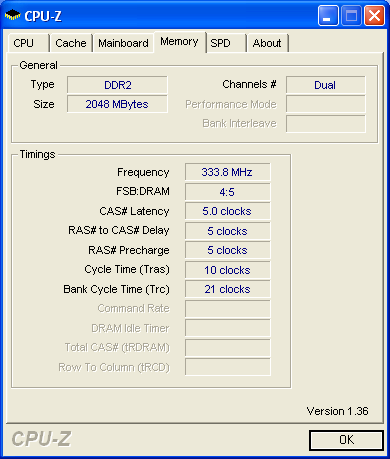
We tried the preset overclocking settings, and only Step2 (280FSB) was bootable:
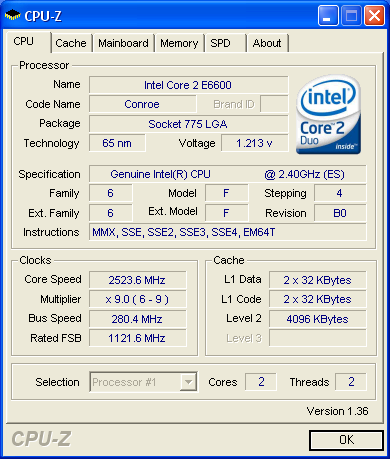
We also tried several manual settings, however we didn't have much luck overcoming the 9x multiplier and 280FSB barrier. The voltage settings option is not the best, since it provides relative offsets from the default (whatever that may be), so you have to try by feeling around in the dark as it were:

9. Intel GMA 950 chipset
After removing our MSI 7600GT graphics card, it was time to see how well the integrated VGA card would perform. For all tests, we used the driver included in the bulked disc, version 6.14.10.4543:

Using Everest Ultimate Edition 2006, we see more information about the chipset:

And graphics capabilities. Both GPU/RamDac are clocked at 400MHz:

From the control panel, we can set various properties:





Then, we tried to fire up 3D Mark06 to see how the device would perform, however we got an error message:

SplinterCell: Chaos Theory, also refused to run

Prey managed to run at a very slow frame rate and with the lowest resolution (640x480) and/or lowest/highest visual quality settings:


PCMark05 awarded the on-board Graphics Card 1475 marks, rather low.

So you shouldn't have many expectations from Intel's GMA950, at least for 3D person shooters. On the bright side, we saw NBA Live 07 running just fine at 1280x1024 with all details maxed out (no AA/AF). So there are chances that some games may run smoothly, and others won't. On the application side, Word, Excel, PowerPoint will run just fine, Video playback is smooth too, but doesn't support any kind of hardware acceleration for ASP/AVC Mpeg4 content, so your CPU will handle most of the load.
10. Conclusion
 Foxconn left us with the best impressions with their previous tested C51XEM2AA motherboard, aimed at the AMD AM2 platform. The shipment of Core2Duo processors made us curious as to a comparable Foxconn proposal, so we were keen to test out the 945G7AD-8EKRS2H, a product with specific features and properties.
Foxconn left us with the best impressions with their previous tested C51XEM2AA motherboard, aimed at the AMD AM2 platform. The shipment of Core2Duo processors made us curious as to a comparable Foxconn proposal, so we were keen to test out the 945G7AD-8EKRS2H, a product with specific features and properties.
First of all, this motherboard supports all currently sold Intel processors for 775 socket, Intel Core2 Extreme, Core2 Duo, Pentium 4 EE, Pentium D, Pentium 4 and Celeron D. Another special feature is the integrated graphics card, again from Intel, the GMA950. While it doesn't offer much for 3D acceleration, it is a good choice for office users. Some games are supported (for example NBA Live 07!), but it really isn't intended for games. Don't forget, that with this board and a Core2Duo processor, you can install out-of-the-box Mac OSX 10.4.7, since Intel's GMA950 is natively supported. If you need the extra graphics power however, there is a PCI-E slot to further expand your gaming experience.
The motherboard supports 4x SATA2 II HDD drives and 4x IDE devices, since this board has 2x IDE ATA133 connectors. Unfortunately, while expansion connections for USB2.0, 1394b and COM2 are available, the retail package does not include the the cables required.

There are some complaints with the layout, with some components being too close to the CPU socket, making it difficult or impossible to use any of the larger fan cooling solutions. And if you're thinking of installing a PCI-E graphics card, you won't have access to the memory modules, unless you remove it each time.
The Foxconn Live Update software finds the latest BIOS and driver updates for your system and installs them automatically, a nice feature, especially for the more inexperienced users.
Compared with Intel's 975DX motherboard, we found the Foxconn 945G7AD to be not only as fast as the 975DX, but in several tests, even faster! That of course has more to do with the memory timings that each motherboard adopted with the specific processor. But the good news is that your new Core2Duo would be a perfect match for this board.
Lastly, we can't but mention the disappointing overclocking capabilities. While several settings can be set, they are not at the same level of what we would love to have. But don't forget that this is an entry level model, so such minor "problems" can be overlooked.
The price starts at around US$120, making it perfect for your new PC system setup. Another good product from Foxconn.